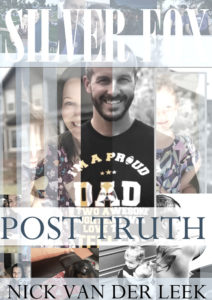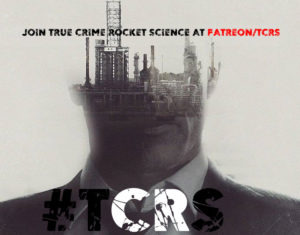This site is called True Crime Rocket Science for a reason. True crime isn’t simple, or easy. Even experts [especially experts] and FBI agents with decades of experience can be totally out of their depth when it comes to a particular case.
The secret to understanding true crime is like true crime itself, simple – but not easy. It requires truckloads of time to become familiar with a case, with the case file and most important, to get to know the true face of the criminal and the victims involved.
As so often happens in true crime, this most important information – who the murderer really is – is carefully hidden from view or missing. It’s not there, it may not be visible, but it does exist. It takes a long, long time to carefully find those missing, concealed, covered up, manipulated and misleading distortions and know how and where these point away from reality.
True crime is like assembling an enormous puzzle made up of many tiny pieces. It takes a lot of time just to develop a cogent picture in one area, never mind the crime itself as a global whole.
The media, who like to rush in and with a snap of their fingers, reveal the secrets no one else can, treat true crime as a cash cow that one can approach lightly, apply one’s hand and voila, there’s the milk. And there’s the money. And the media think they have a foolproof formula for milking their cash cow: Send in the clowns experts!

Experts are often like journalists and reporters, they jump from cases to case like butterflies to the next flower. They nourish themselves by visiting as many flowers as they possibly can in a given day and they think this gives them expertise. I say it again – true crime is simple, but not easy. One develops mastery, and becomes a master – at anything – by devoting significant amounts of time and effort getting to know that thing. So by that token, those people who have immersed themselves for the longest time, consistently focused on only one case day by day are going to know the most about it. Who do you think qualifies according to these standards of expertise in the Chris Watts case?
Even detectives investigating crime and lawyers prosecuting them have to visit other flowers while doing their jobs. One of the few people who stick with a case from beginning through the middle right through to the bitter end is the narrator. This is why journalists covering a true crime case at the scene, in court, all the way to the verdict, are often the best sources. They know how it all ties to together and can intuit the subtleties. And if true crime is one thing it’s subtle.
This is why labels are so irksome in true crime. Labels are like giant rubber stamps, simplifying a crime and criminal psychology, and almost always OVERSIMPLYFYING it. And here’s a case in point from the reputable and reliable [?] Rolling Stone magazine.

I’m always interested to read about the psychology of crimes and criminals, because it’s typically the Undiscovered Country of true crime. Everyone asks about motive, everyone wants to know why, and yet often even with the benefit of dozens of investigators, cops, lawyers, even a court case going on for years, cases come and go and the why remains unanswered. It doesn’t have to be this way, but such a simple question requires a lot of work, a lot of effort, and a lot of the most difficult thing – thinking – to drill towards anything resembling a worthwhile answer.
Now let’s drill into this analysis into the imputed psychology of Chris Watts.

Apparently Watts “fits squarely” into the square psychology box for family annihilators. Actually, he doesn’t fit squarely at all. The article goes on to describe the typical traits leading up to a family annihilation: an inciting incident [such as a job loss], scenarios for long term strife in the home [wife’s infidelity] and/or a history of domestic violence. And most prototypical of all, the perpetrator tends to commit suicide after the act.
In effect the family annihilation exposes a family that is breaking a apart against the will of the perpetrator, and the sense of despair is so chronic and threadbare, there are clear signs of desperation and depression. The killing of the family is almost an attempt to preserve the family so the family can “be together” in the afterlife. In effect the perpetrator feels hopeless, wants to kill himself, but can’t bear the thought of his significant other and children being with someone else, and so he “takes them with him”.
It should be obvious that none of this is present in the Watts case. The inciting incident isn’t infidelity from the wife, but the perpetrator although one could argue Shan’ann’s pregnancy and her MLM work in general was the equivalent of a job loss, or a scenario that rendered his income null and void. Still, it’s not quite the same as losing one’s job and facing despair and hopelessness. If anything, Watts’ job was going well, and Shan’ann’s appeared to be going well. Strife at home isn’t completely absent, but if there’s one thing that stands about about the Watts case it’s the impression that they were a happy and perfect family. And far from Shan’ann being a victim of domestic violence, she wanted to stay married and wanted to make it work and wanted to fix things in spite of her suspicions.
The other aspect to note is that Watts wants his family to break apart, and wants a divorce, and wants another life with someone else. This is completely opposite and counter to the psychology of annihilators.

The impressive sounding Dr. N.G. Berrill [“a forensic psychologist and director of New York Forensics, a private consulting group in New York City”] is right that a family annihilation is “the culmination of a very bad situation that’s festered”, but before awarding Noddy badges for this brilliant insight we ought to remember that ALL CRIMES take place as a culmination of bad, festering situations.

Even a car accident isn’t accidental, but tends to happen at the end of a long period of recklessness, whether in terms of driving, or taking risks in terms of driving when drowsy. Far more car “accidents” are narrowly avoided, and people tend to learn and adapt from these near misses. So even car accidents at the end of a long road of festering un-roadworthiness.

Berrill’s references to patterns misogynistic behavior are also off, unless the references to Watts’ “animalistic sex” have some truth to them, which isn’t impossible. Watts’ clearly is on the more “repressed” side of Berrill’s continuum, but it’s a stretch to conflate Watts’ introversion and crushed-in personality with depression. If anything Watts had been happier than he’d ever been when he committed triple murder, and in addition to that in the shape of his life.

If that isn’t a disqualifier from the typical annihilator pattern – a deliriously happy Romeo – I’m not sure what is. There’s also no indication that Watts committed these crimes as part of a psychotic break [in the way Berrill implies], because a premeditated murder is by default a meticulously planned and executed crime. It’s the opposite of a psychotic break caused by trauma or despair.
Interestingly in Watts’ Second Confession, he seems to suggest exactly this, that his crime wasn’t premeditated and that it was a kind of psychotic break from reality.







When Watts says “if something like that happened” – well it DID happen. It’s not hypothetical although his fictional confession [for him] clearly is, just as the first was also hypothetical, and was presented to him by the investigators as a hypothesis.

Watts refers to this idea of “rage” many times in the Discovery Document. A filtered search shows 191 instances of the word “rage”, although many also include “garage” and “encourage”. In the 30+ page Second Confession report, there are just two references:


I’m sure Watts did feel anger and resentment, and his childhood and marriage, and introverted non-confrontational approach certainly provide fertile soil for some of those feelings. But does Watts strike one as the “enraged” type? Did he appear angry at any time when the cops were searching his home? How about during his Sermon on the Porch? During the hours and hours of his first two interviews and polygraph test, did he come across enraged then? When he was finally arrested did he appear irritated or flustered? When he appeared in court and was told what a monster he was, did he look up and glare at his accusers? After months in prison, does he appear angry or enraged now?
Did we see any traces of Watts’ rage in any of Shan’ann’s dozens of Live videos where he appears?
And in Watts’ version of events, when he murders Shan’ann and the children, does something trigger this rage? He has sex and makes up wih Shan’ann [supposedly] in one version, and in his spiel regarding the snuffing out of the children in the truck at CERVI 319 there is zero trigger.
Watts’ first confession, in contrast, is all about triggers. Shan’ann kills the kids and this sets off a rage in him. He tells Shan’ann he wants a divorce [in this version she doesn’t know about an affair], and this triggers her to kill the kids.



I don’t think rage is the operative emotion in the Watts case. It’s not irrelevant, because there was a long fuse effect [also referred to as the “slow burn” in the Oscar Pistorius trial]. I won’t say here what the operative emotions are, as I deal with them in the books. I doubt whether rage is the operative emotion in the typical annihilation either. There, even though I haven’t studied it as a category, I’d assume the operative emotion is despair. I say this because I suspect it’s similar to the operative emotion in mass shootings where the killers shoot themselves after making a huge statement. Once again in these scenarios, which I studied and profiled extensively in SLAUGHTER, while rage is present, the operative emotion which is even greater is despair, which is itself a function of massive humiliation and diminishment over a long period of time.
Back to the Rolling Stone “expert” psychological analysis. After describing the Watts case as fitting squarely into the pattern of family annihilator, the writer seems to readjust his view and describes Watts as “somewhat unique”. Ya think?

Then another expert weighs in, Dr. Neil Websdale, director of the Family Violence Institute at Northern Arizona. After Berrill puts Watts into the prototypical Family Annihilator Box, Websdale takes him out and puts him into the Narcissism Book, and closes the lid. This version of Watts is a self-centered, entitled, aggressive narcissist. And of course that’s who we see in all the Facebook videos. Watts taking center stage aggressively, and being entitled to his own paychecks throughout his marriage, and always only thinking about himself. Except…ahem…this isn’t an entirely accurate representation from the director of the Family Violence Institute. Besides the murders there is virtually zero family violence to speak of in the Watts case, so getting a Family Violence Institute expert on the show may appear to be good journalism, but it’s shockingly out of touch with the true crime merits of this case.

Steven Lambert, the Rzucek’s family lawyer is referenced next providing the insight that Shan’ann’s threat to fight for full custody is the real reason for the murders. Really? So Watts killed his wife first, and then having achieved custody, killed his children…?
Once again we have an extremely poor application of the facts of the case, but of course if it’s a lawyer or an expert it must true.
A good example of murder in order to “win” an actual custody dispute, where custody is a central motive took place just up the legal road in Colorado, in the Patrick Frazee murder of his fiance Kelsey Berreth. I want to deal with that case as a possible poster for the psychopath label.

In the Frazee case there was literally the bludgeoning to death in front of his daughter, and then the removal of the little girl from the scene, and then in the weeks following, a civil trial for custody playing out alongside the criminal trial for murder. That’s what a murder with a custody motive looks and feels like.

Before moving onto a proper comparison with Frazee, there’s a final aspect to deal with in this article about psychology from the so-called experts. Websdale signs off by describing intimate partner homicide as a weird sort of psychological enigma where anything can happen and nothing can be predicted. It’s all sort of random, you see. Websdale confidently notes that each time he’s asked about this issue he tells people there are no signs; you can’t predict it at all. That’s hogwash.
The same signs that were in play in the Scott Peterson case are in play in the Watts case, and for that matter, the Frazee case as well. There’s a period of standoffishness that precedes the crime. There is disenchantment, withdrawal and disinvestment. There’s an attempt to extricate one life from another that’s both explicit and tacit. If there’s loving behavior and consideration at one point, this pattern shifts noticeably towards its antithesis. We see the same thing with mass shooters and people who commit suicide. Any premeditated murder that goes on for any length of time is preceded by psychological and emotional preparation. It’s the cooling, the breaking of psychological and emotional attachments before the culling. And all of this plays out over again, like a movie clip set on repeat, in the soon-to-be murderer’s mind. Murder becomes a fantasy, but how that fantasy plays out in the real world is through real world disaffection with his intended target.
In the Watts case the signs were plentiful, from his sudden uncharacteristic lack of communication in general to his expressed fear and anxiety about having the third child as well as his resistance to announcing the gender reveal.
Besides this, the debt monster was a clear and present wolf howling at the front door, just as was the case in the murder of Laci Peterson.
So if we’re to conflate these cases with those of family annihilation, then we see unique signatures emerging from the ether: a pregnancy or newborn child, severe financial limits and an affair all providing an entirely different dynamic.
It may be better to refer to these kinds of crimes as Pregnancy Annihilation because at its center that is what it is, and probably how it starts. The murder is a dramatic way of enforcing an abortion in circumstances where the husband and father feels too inadequate [financially and otherwise] to broker or negotiate with his spouse the way a normal husband or father would. Murder, in effect, is the “easier” way out for them [because they’re cowards with weak social currency but strong/resilient connections to their own parents].
What Drives a Man to Kill His Own Family? Inside the Psychology of Family Annihilators – Rolling Stone

Now I want to address the biggest bugbear, for me, in this case. The only label more ridiculous for Watts than the Narcissist label is Psychopath. To understand why it’s such a misnomer, let’s look at what a truly psychopathic crime and criminal feels like.
Kelsey Berreth’s fiancée, Patrick Frazee, is a ‘monster,’ ex-girlfriend says – NBC

Without going into a lot of detail, we can see how the circled text doesn’t apply to Watts. He has empathy for his family right up until the time he kills them. He even has empathy for the investigators interrogating him, apologizing to them afterwards for lying.
Watts is also terrible at reading people, from his mistress [and her anticipated response to Shan’ann’s disappearance] to law enforcement to the media. His Sermon on the Porch is one of the least convincing misrepresentations to the media in the history of high profile true crime.
Watts thinks he’s clever, and a good liar, doesn’t he? He vastly overestimates himself on both counts, perhaps due to several years of MLM playing loudly in the background, with the Criticism and Fact Checking button permanently set to mute. But it would be overstating things to suggest Watts is a dummy in every respect.
Certain technical aspects of the crime were brilliantly executed, and plenty of evidence has been permanently lost, which is no mean feat in a “hastily executed flying-by-the-seat-of-his-pants” crime as some believe it to be. We still don’t have any independent proof for where the crimes took place in the home which is virtually unheard of in high-profile true crime.
Curiously the Scott Peterson case shares this idiosyncrasy with Watts – we can’t be sure where Laci was murdered or when either, but there is evidence plenty of bleach was used on the scene.
In the Amanda Knox case, there is less uncertainty about where the crime to place, but it appears there was a significant amount of cleaning up of the crime scene, and it appears bleach, household cleaners and doing the laundry suddenly became priorities that morning. In the Steven Avery case, bleach is also prominent, and evidence of the victim almost entirely absent.
There’s virtually no evidence Watts was emotionally abusive, to anyone, nor that he was cruel to animals. But if Watts doesn’t fit the profile of a psychopath, that doesn’t mean there aren’t a few psychopathic traits in Watts.
Like Frazee, Watts put his wife on a pedestal [and she did the same to him in some respects]. By doing this, the perpetrator idolizes his partner, which is the first step in distancing and disconnecting himself. Tearing down and burying is the final step.

Another aspect of Watts that conforms to the classic psychopath scenario is his “second face”, a secret identity hidden from the world which is nevertheless present. Scratch the surface, peel away the veneer, and there he is. But this trait is one true of almost everyone. On social media, and Facebook in particular, most avatars present a second, fictional face to who we really are. What this shows is a link between narcissism, psychopathy and social deception, and something else: as much as we believe Watts to be an alien monster that is nothing like us, he is very much a product of our time. He is us.

The 6-part TWO FACE series is available on Amazon at this link.






















































Recent Comments